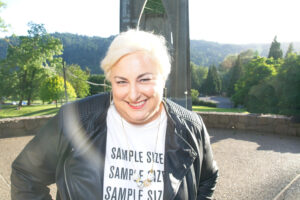Switchback at TRE, December 2-4, 2025 in San Antonio, TX
•
Switchback Spring, June 16-18, 2026 in New Orleans, LA
 Andrea Kelly, founder and CEO of Make Plus Equal, grew up exploring the outdoors, and like most self-described gearheads, she’s always enjoyed prepping for adventures—except when shopping for clothes.
Andrea Kelly, founder and CEO of Make Plus Equal, grew up exploring the outdoors, and like most self-described gearheads, she’s always enjoyed prepping for adventures—except when shopping for clothes.
“I was plus size, and more often than not, I couldn’t find what was right for me,” says Kelly, founder and CEO of Make Plus Equal, an organization that champions size inclusion in the outdoor apparel industry. “I was wearing whatever I could find, including men’s things that didn’t fit properly or work well. I just figured I was an anomaly and that I was just going to have to settle for what I could find.”
Kelly’s love of the outdoors carried into her career, and for 25 years, she worked in product development and merchandising for global apparel brands, including Nike ACG and Columbia Sportswear. While working at Columbia, Kelly came across a study that made her realize she wasn’t an anomaly when it came to shopping for clothes. In 2014, Plunkett Research reported that 67 percent of women in North America were considered plus-sized (women’s size 14 and up).
At that moment, Kelly made it her mission to promote the manufacture of plus-sized clothing in the outdoor industry. While Columbia Sportswear carried a broader range of sizes than most apparel makers, she convinced the company to go even further and increase its offering of plus sizes. “Columbia was the first place I worked in my career where I could actually wear the product I was building,” she says.
Unfortunately, most outdoor industry companies have been slow to incorporate plus-sized clothing into their lines, including some of the largest brands, says Kelly. “There’s an assumption that plus-sized people aren’t active and outdoorsy, but that’s not the reality,” she says. “There are actually tons of people doing these activities.”
While some companies fail to understand plus-sized consumers, others are hesitant to make the necessary financial investment to design, manufacture, and market larger clothing. “It does take more money to build out these products,” says Kelly. However, companies could increase revenues by expanding their customer base to include plus-sized people.
Frustrated with the pace of change, Kelly launched her consulting firm, Make Plus Equal, in 2023. Utilizing her extensive knowledge and experience in the apparel industry, she helps companies create plus-sized clothing and promotes size inclusivity in the outdoor industry.
A Broad Range of Services
While Kelly knows apparel manufacturing inside and out, she is also a plus-size consumer, bringing a unique perspective and a distinct set of skills. She can assist companies at any stage of their journey to become more size-inclusive. If a company is beginning to explore the option, Kelly helps them better understand their potential customers. “I can educate manufacturers on what this market is looking for and what they need and how to engage with them,” she says.
Some companies know their target market but need help taking the next steps in planning, designing, and producing their clothing. “I just met with a small start-up company that’s making women’s overalls,” says Kelly. “They want to make bigger sizes but said they weren’t sure how to do it.”
Whether a brand needs help with product design, budgeting, production planning, or marketing, Kelly can assist companies in incorporating plus-sized manufacturing into their processes. 
According to Kelly, some companies seek her advice for the design process because plus-sized apparel requires unique patterns. (If a company uses a regular “straight” pattern to create larger sizes, it’s called “extended sizing,” which is different from creating plus sizes.)
As a company develops new designs and patterns, Kelly can connect the factory with plus-sized people for fit sessions and wear testing.
Once a brand is ready to introduce its plus-sized apparel, it must also understand effective ways to market the products, says Kelly. “They have to connect with the consumer where they are, use the appropriate language, and engage with social media to sell to this new market that they may not have tapped into before,” she says.
A Champion for the Cause
While research shows that most women in North America wear plus sizes, the outdoor industry and broader fashion industry have been slow to respond, says Kelly. So, a critical part of her job is being a champion for plus-sized clothing. “The message I’m trying to sell is that you’re missing a large potential market,” says Kelly, noting that she devotes a lot of time to public speaking and connecting apparel makers and market influencers with people in the plus-sized community.
“I have a lot of connections with plus-size athletes who can share stories and work with marketing teams and design teams. So, it really comes down to education, public speaking, and connections,” she says.
While Kelly is optimistic about her work, she says it’s difficult to convince the industry to change course. “This is the slowest boat I’ve ever been on,” she says. However, she’s hopeful.
“Many of these brands already have the talent and resources,” she says. “It’s not re- inventing the wheel; it’s just considering another type of body when you’re building your product out.”
For manufacturers, it’s also a matter of recognizing that apparel can pose a barrier to enjoying the outdoors. As Kelly has learned from her own experiences, a painful shopping trip can leave a person feeling uncomfortable about trying a new activity. When companies offer plus-sized clothing, they increase access to recreation and help grow the market.
“They’re enabling more people to get outdoors,” says Kelly. “And that’s what the outdoor industry is all about.”
